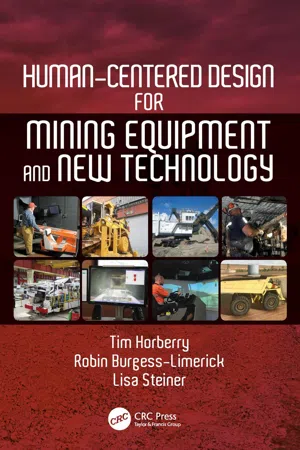
Human-Centered Design for Mining Equipment and New Technology
- 125 pages
- English
- ePUB (mobile friendly)
- Available on iOS & Android
Human-Centered Design for Mining Equipment and New Technology
About this book
Human-Centered Design for Mining Equipment and New Technology first introduces Human-Centered Design (HCD) and outlines the benefits of this approach for mining equipment and new technology: HCD is a process that aims to make equipment and systems more usable and acceptable by explicitly focusing on the end-user, their tasks and their work environment/use context. The book outlines three linked areas of mining HCD: key principles, examples of design processes, and what kinds of tools for data collection and evaluation are available.
The possible future uses of Human-Centered Design in more fully automated mining are presented, and the role of HCD within wider human system integration are outlined. The 'how to' nature of this book makes it attractive to mining equipment manufacturers, technology developers, mine site personnel, human factors researchers, safety scientists and regulators.
Features:
-
- Includes an introduction useful to anyone wanting to learn about the field
-
- Provides extensive case studies of HCD which also show failures when HCD was not considered
-
- Covers cutting edge mining technology- such as proximity detection devices and new mining automation systems
-
- Directly outlines the benefits of HCD for the minerals industry
Human-Centered Design for Mining Equipment and New Technology, through case studies, provides a much needed guide to undertaking HCD for mining equipment and new technology.
Frequently asked questions
- Essential is ideal for learners and professionals who enjoy exploring a wide range of subjects. Access the Essential Library with 800,000+ trusted titles and best-sellers across business, personal growth, and the humanities. Includes unlimited reading time and Standard Read Aloud voice.
- Complete: Perfect for advanced learners and researchers needing full, unrestricted access. Unlock 1.4M+ books across hundreds of subjects, including academic and specialized titles. The Complete Plan also includes advanced features like Premium Read Aloud and Research Assistant.
Please note we cannot support devices running on iOS 13 and Android 7 or earlier. Learn more about using the app.
Information
1 Why HCD for Mining Equipment?
1.1 OVERVIEW
1.2 WHAT IS HCD?
1.3 APPLICATION OF HCD TO EQUIPMENT AND NEW TECHNOLOGIES USED IN THE MINERALS INDUSTRY
1.4 KEY POINTS OF HCD
- It is often now used as an umbrella term, covering other terms such as “user-centered design,” “interaction design,” and “design for product experience.”
- Similarly, it uses knowledge and techniques drawn from human factors, ergonomics, and usability engineering, but is not the same as these topics.
- It is different from other design movements such as technology-driven design or sustainable design. Technical innovations or environmental impacts are not the key focus of human-centered design.
- The focus is upon making systems and products more usable, useful, and acceptable and less likely to result in adverse safety or health effects.
- The aim is to bring benefits such as improved productivity, user well-being, accessibility, fewer errors, and reduced harm.
- It fits the product, system, or interface to the user, not vice versa. It tries to optimize the system/equipment around the ways users can, want, or need to use it, rather than forcing them to change their behavior to accommodate the product.
- It requires an understanding of the users, their tasks, and the environment/use context.
- Users and other stakeholders should be involved throughout design and development.
- The design is iterative and driven by human-centered evaluation criteria (e.g., usability/safety).
- The needs, wants, and limitations of all people who may interact with a product or equipment are given explicit attention at each stage of the design process.
1.5 THE BENEFITS OF HCD . . . AND THE FAILURES OF NOT TAKING A HUMAN-CENTERED APPROACH
- Increased user productivity/fewer errors
- Increased sales
- Decreased training costs
- Decreased user support
- More accurate end-user requirements and better system usability
- Fewer costly system features that are unwanted or irrelevant to the task
- Improved operator acceptance and understanding of the system/product
1.5.1 PARTICIPATORY ERGONOMICS AND HUMAN-CENTERED DESIGN
Table of contents
- Cover
- Half Title
- Title Page
- Copyright Page
- Table of Contents
- List of Tables
- List of Figures
- Foreword
- Acknowledgements
- Authors
- Glossary of Terms and Acronyms
- Chapter 1 Why HCD for Mining Equipment?
- Chapter 2 Principles, Processes, and Tools for HCD
- Chapter 3 Current Status of Mining HCD
- Chapter 4 HCD Educational Material
- Chapter 5 HCD Case Studies
- Chapter 6 What Now for Mining HCD?
- References
- Index